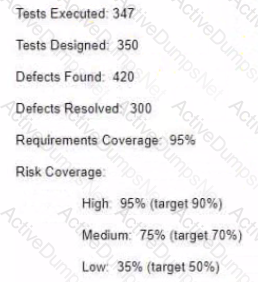ISTQB ATM Advanced Test Management Exam v 3.0 – ISTQB Exam Practice Test
Advanced Test Management Exam v 3.0 – ISTQB Questions and Answers
You tend to be conservative in your project estimations because you know how many things can go wrong and extend the schedule. You manager is not happy with your estimates and thinks you are being too negative with your numbers and not trying hard enough Which estimation method should you use to provide your manager with a positive' number while still also providing the number you think is more realistic?
In an Agile project, when Is it acceptable lo not write a formal defect report when a defect is found''
Your team has been assigned to test a loyalty card programfor a supermarket chain.Because this is a highly competitive market significant investment has been made to determine the shortcomings of the products offered by competitors While the feature sets are mostly the same, there is a wide variance In usability and performance and the users perceptions of these quality characteristics
Given only this information what test approach would be most appropriate?
Which of the following best describes the appraisal costs in the cost of quality'
At what testing level do the test management activities Include coordinating with end users7
Which test process improvement model consists of five maturity levels?
Your defect opened trend is converging to the closed trend but there is still a gap. What does that gap represent?
You have been asked to make a recommendation on deployment readiness on the software your team has been testing.You have the following metrics:

Given this information what is a critical metric you are missing?
There is a debate in your organization about who can close a defect report The developers think theyshould be able to reject and close defects without any further steps The testers are not happy with this approach as they are afraid the rejections may go undetected and the developers may close something without understanding the real problem
How can this problem be rectified7
If you are monitoring code coverage during testing to determine what areas still need testing what type of testing is likely occurring?
You are managing the testing for a bank card project.The testing was scheduled to take 10 weeks but by the time the software was developed only six weeks were available for testing Knowing there were a lotof risks with the software your team started testing activities early by overseeing code reviews, defining acceptance criteria by working with the users and by doing all lest creation prior to the code arriving
You are now three days away from the go-live date Your testing has mitigated all the high and medium risk items leaving only the low-risk elements unmitigated by testing You estimate it will take two weeks to manually test the low-risk elements At this point what should you do?
Which ofthe following Is the common setof information to be produced in a test estimate''
You feel that your team has become lazy when applying good software testing techniques You have given each of them a challenge to take a different business rule and build a full decision table and then collapse that table You will then assess the results For this assessment, whatcompetencies are you validating?
You have decided to help your team improve their skills. One of their assignments is to mentor a junior member of the team Which competency should you expect the mentor to develop during this exercise?
You have been looking at the actual vs expected defects in one high risk area of the software The actual is much higher than the expected value What should you do?
